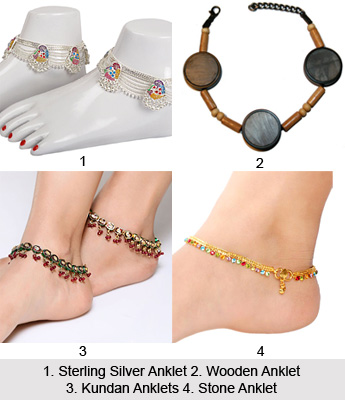 Anklets are most commonly known as ankle bracelets. This is a kind of jewellery worn around the ankle. It is a traditional Indian form of jewellery called Payal or Pajeb. Over the world these Indian anklets are celebrated and reputed for their beautiful cuttings, ornamentations, and countless styles. According to Indian custom, unmarried girls can only wear anklets. Anklets have small bells that while walking emit a melodious noise. That is how they draw attention to the wearer`s feet. Both men and women in western culture wear casual and funky anklets. Formal anklets are however, circumscribed to women.
Anklets are most commonly known as ankle bracelets. This is a kind of jewellery worn around the ankle. It is a traditional Indian form of jewellery called Payal or Pajeb. Over the world these Indian anklets are celebrated and reputed for their beautiful cuttings, ornamentations, and countless styles. According to Indian custom, unmarried girls can only wear anklets. Anklets have small bells that while walking emit a melodious noise. That is how they draw attention to the wearer`s feet. Both men and women in western culture wear casual and funky anklets. Formal anklets are however, circumscribed to women.
For long, exquisite, single and feminine anklets have adorned the legs of women. In India anklets are found in many variety and styles. Largely they are made of gold or silver. Apart from that, one can choose from chunky anklets, anklets embellished with precious stones and gems, delicately designed anklets, beaded anklets, etc.
The variety is so vast that one can opt for any sort of design that is both attractive and beautiful.
Flexible and Inflexible are the two types of Anklets. Flexible anklets are made by `tying links in a chain attached by hooks to toe rings and are worn by a bride in marriage`. Sometimes small bells are attached on the outer edges of the anklets that make a `tinkling sound` when a person walks. The latter, are created from shaping flat sheets of metal and do not require as much skill as is required in the flexible ones.
In contemporary times anklets are made of sterling silver, gold, beads, semi-precious and precious stones. They are quite popular all over the world. Youngsters these days wear anklets on just one foot in the name of fashion. An anklet is usually 2 - 3 inches larger than the size of the ankle. They are made larger in order to make it comfortable for the wearer. Gold or gold plated anklets are best fitted for a traditional look for an auspicious occasion. Thin silver or oxidised anklets are best suited for a modern yet ethnic look. Silver or oxidised anklets look good with colourless stones or semi-precious stones
studded in it.
Depending upon the material used to make anklets, they can be categorized as:
Sterling Silver Anklet: Sterling Silver anklets are the ones available in contemporary designs. Sterling Silver Anklets are considered one of the most-sold types of anklets in the international market. Young girls usually wear anklets that are often embellished with colourful stones, beads of plastic and glass.
Shell Anklets: Designed exclusively shell anklets are generally associated with women and not men. These fashionable anklets are particularly manufactured in Indonesia and then exported to different countries. The look of the anklet is usually determined by the size of shells as they can vary from heavy and chunky to simple ones as well.
Plastic Anklet: Plastic Anklets are undoubtedly innovative ones. These type of anklets are designed mainly by using soft and light weight plastics. Other materials like beads, metal etc. are also used for making a variety of designs. These anklets are made using animated coloured plastics.
Wooden Anklet: Wooden Anklets are general beaded. One can find wooden anklet in both natural coloured wood and coloured wood. Tribal and traditional designs are much sought after in wooden anklets. Sometimes these anklets are often given a distinctive look by mixing the wooden beads with plastic or leather beads.
Stone Anklet: Stone anklets are made using a range of stones and in-expensive gemstones. The stones are exquisitely brushed to give a dazzling look to the ornaments. Besides the countries India, China, Indonesia, Italy etc. these anklets are made in other countries as well.
Bone Anklet: Bone anklets serve the purpose to draw attention to the wearer`s legs and feet. Each piece of bone anklet is crafted by hand because these exotic pieces cannot be made mechanically. Unparalleled pieces are also custom made. Some bone anklets may admit exotic graces of shell or precious stones.
Glass Anklet: Glass anklets are the "in thing" in order to give a distinguishable look to one`s legs. Glass beads produce distinctly separate unique pieces of glass anklets in several shapes, sizes and colours. Along with glass beads, beads of other materials can be mixed-and-matched to bring in the effect of gorgeous ornamentation. To bring in a heightened effect for glass anklets, they are generally coordinated with the colour of the dress.
Jute Anklet: Jute Anklets are considered immensely fashionable and trendy to a great extent. To give a charismatic look to these anklets, they are mixed with beads and stones. The excellent workmanship can be seen described through jute anklets that are simply adorable.
Ivory Anklet: Ivory Anklets are also considered as unique piece of costume jewellery. Anklets are exquisitely carved from ivory and they have become quite fashionable. These anklets are extremely popular amongst the young crowd as these give a trenchant look to the wearer`s legs.
Anklets are available in the market in miscellaneous designs. In India one can find anklets made of lac and kundan with gold plated beads and coloured pearls. Leather anklets are made in the western countries with funky patterns, usually worn by men.









